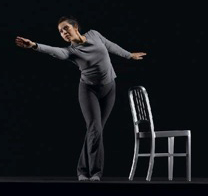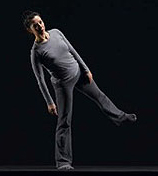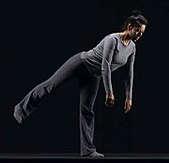Inside your inner ear, deep in your skull, are the remnants of seashells, filled with liquid and small, hairlike cilia. This beautiful construction is called the vestibular system. Your vestibular system allows you to know when you are upright or when your head is tilted to one side. The vestibular system is so sensitive to the movement of its own fluids that the slightest change is detectable and requires a reaction. For example, if you turn your head from side to side rapidly, or spin like many children enjoy doing until they get dizzy and fall over, you’re stimulating your vestibular system.
 As we get older we move more slowly and with fewer radical changes of position, so our vestibular system is less stimulated. This is a visible sign of aging.
As we get older we move more slowly and with fewer radical changes of position, so our vestibular system is less stimulated. This is a visible sign of aging.
The best way to get your eyes, inner ear, muscles, and brain working and sensing together is to move in a style similar to the way you moved as an infant and young child. These developmental movements encourage your head to be in many different positions as you roll it to scan with your ears and eyes while you move from lying on your stomach, lying on your back, and side-lying, to kneeling, crouching, and standing up and balancing. These movements provide a slow, steady, consistent return of what’s often lost in our vestibular system as we age.
Here are a couple Change Your Age tips on how to transform your balance habits and a sample lesson from the book Change Your Age.
How to Transform Your Habits
TIP #1: Stand with your right foot crossed over your left foot. Look up as if reaching for something. Reach with one arm and then the other. Let your pelvis move in the opposite direction that you reach. Repeat this movement with your left foot on the outside of your right foot. Reach all around yourself, in every possible direction, and feel how your pelvis and feet support you. Remember to breathe and feel your breathing while you’re doing this. Smile!
TIP #2: Practice walking forward and backward slowly (about ten seconds for a step). Do this next to a wall for support if you are feeling unsure of yourself. As you become more comfortable and sure-footed, you will be able to walk backward faster with ease and your balance will improve walking forward.
Balance Habits- Sample Lesson
This lesson asks you to be intuitive and instinctual and to trust yourself. Unlike other fitness books, you won’t find strict rules on repetitions or time limits here; I’ll suggest parameters, but the Change Your Age program is about being in touch with your body and brain—and your sense of movement.
Before you start this lesson, read through it and look to the photos for guidance. This mental rehearsal will help you unleash your physical imagination.
- GO SLOWLY—Take your time, you’ll learn more!
- INSIST ON COMFORT—If it hurts, it’s not helping you. Never try to override pain if you feel it.
- USE YOUR IMAGINATION—Allow the movement to become very clear and lucid in your mind, like a scene from a movie.
- REST FREQUENTLY—These movements, while gentle and pleasurable, may cause slight strain because you are using parts of muscles you may not have used in a long time, or you may be using them in ways that are not familiar.
- CHOOSE A COMFORTABLE SPACE—Make sure that you have space around you to move and that your clothes are loose enough to not restrain your movement.
Lesson 28: Standing on the Highest Point of the Hip
Intention: To find the highest point of your hip joint so that you can include a feeling for this point in your way of standing and walking. Everyone who has any concern about their hip joint as they age should do this lesson.

Many arthritic and osteoporotic conditions are aggravated and accelerated when weight from the pelvis to the head of the femur (or thigh bone) does not go in the direction best aligned to maintain the strength of the bones and the joint. In the ball-and-socket joint of your hip, where you bear weight determines how the internal structure of the femur grows and changes over time.
The best place to bear weight is at the highest point of the hip joint, but many people have the habit of sinking in their hips or standing so that the weight of the pelvis is lower on the ball-and-socket joint of the hip.
Starting Position: Stand with your feet as wide as your hips. You might feel comfortable doing this near a piece of furniture or a wall to help give you balance and support if you need it. Imagine that half of your body is one piece, one unit, from your left leg and your left foot all the way through your spine and torso to the top of your head; think of those parts of your body as containing an unbendable stick. You can only move at your right hip joint.
1. Bear more weight on your right leg so that you can lift your left foot and leg out to the left side of your body and then return to standing on both feet. Your head will have to move exactly the same amount to the right. Let your arms hang freely and do the movement slowly several times.
Change Your Age Tip: Be very careful not to tilt your neck to the right, or your chest or any part of your spine; be sure to stay on top of your right hip joint. You will be moving your pelvis on top of your hip joint. There is no need to lift your left leg very far.
2. Stop and go for a walk. Do you feel the difference in your hips and legs? How do they support you differently?
3. Imagine the same movement on your right side: Your body doesn’t bend except at your left hip as your right foot and leg lift off the floor to the right side and your head moves equally to the left. Now you will be balancing on top of your left hip joint. Don’t try to go too far. Go as slowly as you can. Feel that your right foot and head move the exactly the same distance to the right that your head moves to the left. Make sure your trunk is truly unbendable.
You may want to go back and practice again on the other side. Observe which side is easier.
4. Stop and go for a walk. Feel how your pelvis sits high on your hip joints.
If you feel fatigued in the muscles around your hip joints, lie down and rest for a moment before continuing.
Change Your Age Tip: As you do these movements, all of the stabilizing muscles of your hip joints awaken and, for some people, become fully activated for the first time. The secret is in going slowly and carefully to keep everything immobile except the movement over the hip joint.
 5. Return to standing. Now imagine again that the right side of your body is an unbendable unit. As you bring your right foot forward, your head will go back exactly the same distance. Take your foot and leg backward and let your head go forward the exact same distance. Do this several times. Be sure you are not arching your back and that all movement is directly over the right hip joint.
5. Return to standing. Now imagine again that the right side of your body is an unbendable unit. As you bring your right foot forward, your head will go back exactly the same distance. Take your foot and leg backward and let your head go forward the exact same distance. Do this several times. Be sure you are not arching your back and that all movement is directly over the right hip joint.
Rest. Go for a walk. Observe any changes you feel in your head and hips and how your pelvis sits above your legs.
6. Repeat the same movement on the other side. As you go back and forth over your right hip joint, relax your shoulders and let your arms hang freely in front or in back of yourself, wherever they want to go.
Pause. Observe how you are standing. Feel whether you are higher above your legs. Go for a walk and observe what’s new compared to your usual way of walking. Can you sense your hip joints and the muscles around them in a new way? Practicing this lesson everyday will assure better balance and stronger, more stable hips.
For more movement lessons, tips and helpful routines, buy the Change Your Age book and the Change Your Age video program.
